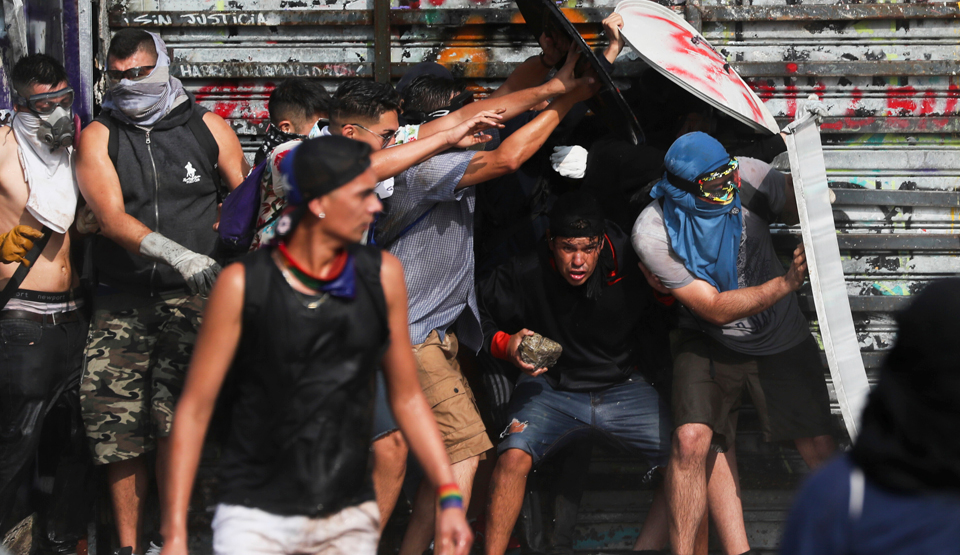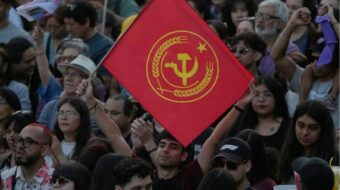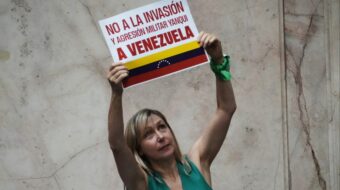
Santiago high school students were the spark. Rejecting a fare hike, they jumped over subway toll barriers on Oct. 18, 2019. Students filled the streets all over. Police action led to injuries and arrests. Some 1.2 million people occupied Plaza Italia in Santiago a week later. After three months, on Jan. 18, Santiago marchers arriving from three plazas demonstrated outside the Moneda Palace, the seat of Chile’s president. Protests took place in 19 other cities.
Aggrieved Chileans have demonstrated and marched throughout the country, week after week. They’ve staged three general strikes. One writer refers to Chile’s “most intense and most massive social uprising.” All along, students have marched in the front lines. Students mobilized massively in 2011.
Chileans despise the government of billionaire President Sebastián Piñera. Polling pegs disapproval rates for Piñera and political parties at 94% and 98%, respectively; 97% of Chileans reject their Congress.
Protesters want Piñera to resign. They oppose privatization of health care, pensions, and education; sell-offs of water rights and mineral resources; and the abuse of indigenous peoples. They call for a constituent assembly.
Government repression has been brutal. So far, 29 protesters are dead, 22,000 have been arrested, and 3,600 wounded—including 405 persons with eye injuries, some having lost eyes. Directives issued on Nov. 7 authorized detention on mere suspicion, search of backpacks, police entry into schools and universities, and penalties for bad-mouthing police, presence at a barricade, and wearing masks.
Giving way a bit, the Piñera government in November canceled the fare increase, raised the minimum wage, and added pension reforms. On Nov. 15, the government announced it would accept a constituent assembly in return for approval of its version of “social peace.” A plebiscite for authorizing a constituent assembly is set for April 26.
By Jan. 13, Chile’s Congress had overwhelmingly approved legislation that “criminalized methods of popular struggle.” Piñera had taken on “powers of a dictator,” complained an observer. Alone among “all the political forces,” leftists included, the Communist Party deputies voted against the repressive measures.
Presently only 14% of the adult population identify with a political party. Since October, political parties of the right and left have lost active members. According to a survey, 5% of the people look to the government for representation and 57% to social movements; 30% of respondents say they are unrepresented; 62% attribute the uprising to economic crisis.
Social movements have led the protests. They’ve unified under the umbrella of Social Unity, which emerged in August 2019 under the auspices of the United Workers’ Central (CUT) plus other unions and social movements. Now, Social Unity encompasses more than 200 member organizations. On Jan. 5, it ended talks with the government.
Social Unity is promoting the constituent assembly in conjunction with a few leftist parties. At a meeting of those parties on Jan. 18, Communist Party President Guillermo Teillier indicated they anticipate “strict coordination with the social world to give expression to many demands in the streets. They will vote for a constituent convention where everybody is chosen democratically.”
On April 26, Chileans will vote on whether to hold a constituent assembly and on what kind of assembly. The government and its allies propose an assembly with half the members chosen by the Congress and with a two-thirds majority required for decision-making. The opposition wants all assembly members chosen by the public. The super-majority provision is seen as delivering veto power to conservatives and centrists.

Struggle over Chile’s Constitution reflects problems left over from the transition in 1990 from dictatorship to democracy. The current Constitution originated in 1980 under the Pinochet regime. It retains toxic elements despite modifications after 1990.
The Constitutional Court retains authority to preemptively reject legislation. Congressional super-majorities are required to alter “organic constitutional laws” applying to “the education system, the electoral system, and Constitutional Court.” Limitations on presidential power are few. The Constitution protects the state’s role in promoting the market economy and imposes few restrictions on putting down protests.
The arrangement in 1990 called for Pinochet giving up power in return for continued constitutional protection of the market economy, police, and military. Chilean analyst Paul Walder sees a similar bargain cropping up now. A new or newly-modified constitution is pay-back for no fuss about severe repressive measures. Center-left politicians support the pact. At issue is the Constitution’s service to capitalist objectives.
Without highly visible leaders or designs on state power, rebellion in Chile might qualify, one observer suggests, as a “passive revolution.” According to one expert, the hallmarks of that phenomenon described by Gramsci are long-term oscillation of revolution and restoration and struggle over societal institutions. Chile’s process has been long: agitation in the 1950s and 1960s, the Allende presidency (1970-1973), and multiple struggles from 1990 on.
Having facilitated the military coup in 1973, the U.S. government is surely paying attention to Chile now. The staying power of right-wing forces may be reassuring, but future troubles with investments and trade undoubtedly are of concern.
Indeed, as noted by a business-friendly news service, “Chile has long been an oasis of stability in volatile Latin America and was consistently among the strongest and most market friendly democracies. But it’s now mired in wide-ranging disruption and chaos and pulling down asset values in the rest of the region.”
One questions the label of democracy, but not “market friendly.” U.S. exports to Chile in 2018 were worth $15.3 billion and imports cost $11.4 billion. Copper purchases accounted for $3 billion. Copper production was nationalized in 1971, but now private corporations control 70 percent of the industry. They pay “practically nothing” in royalties.










